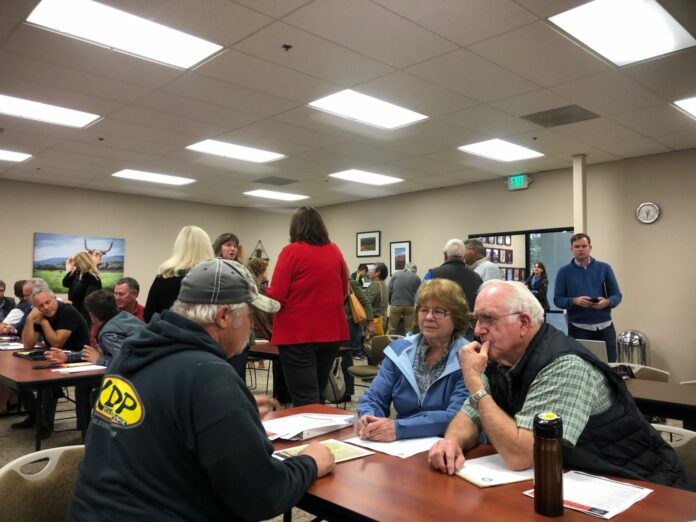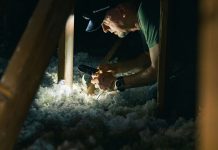
Resource meetings have begun for victims and survivors of the Kincade Fire to help facilitate rebuilding and provide assistance to those that need it.
The Sonoma County Farm Bureau held a meeting for agricultural producers affected by the fires on Nov. 14 and then Gore and his staff led a community meeting at the Alexander Valley Community Center on Nov. 16.
There was some overlap in messaging between the two meetings, but the desire of local agencies to help make people whole seems clear.
While the programs being offered are built from the experiences of the Sonoma Complex Fires in 2017, this fire, and the response to it, will be necessarily different.
A large reason for this is the significant difference in the number of damaged or destroyed homes, which in the case of the Kincade Fire fails to rise to the level of federal emergency which would invoke the participation of federal agencies like FEMA. This means that solutions and assistance are largely state and locally based, which is not necessarily a bad thing, according to District 4 County Supervisor James Gore.
Gore points out that while a lack of federal aid changes the funding structure, it also provides more opportunity for local control and cost savings, along with potentially lower levels of bureaucracy.
“I want to honor your loss, we have too much experience with this, and I want us to embody imperfect, relentless forward progress,” Gore said at the Alexander Valley meeting. “The first thing I hope we do is create a to-do list, and two, if you have needs beyond what insurance programs or the government can provide, I hope we can help create solutions.”
Government gets out of the way
One common theme discussed by various representative of county government was, as Gore put it, “Figuring out how best to help you and also figuring out how we stay the hell out of your way.”
In both meetings representatives from Permit Sonoma, the Department of Health, local watershed agencies, Public Works and Gore himself went to great pains to reassure attendees that they are not looking to cause problems.
Issues such as unpermitted structures, wells that do not meet new requirements and others are of particular concern to rural landowners, many of whom have been on their property for generations. Tennis Wick of Permit Sonoma assured the crowd at both meetings that the organization would work with landowners to come into compliance and also be made whole, without the usual permitting challenges.
Similarly, well systems that have been damaged in the fires can be repaired to their original level, not upgraded to the new requirements, provided they are repairs and no redesign or full replacement is required.
Permitting fees for repairs will be reduced 35% to 40% and Permit Sonoma is pledging a five-business-day turn around time for permits, even setting up new offices to handle the caseload.
That doesn’t mean that property owners can just do as they please, however. Cleanup permits are still required, and the county must be allowed to enter all properties to investigate — and if found remove — household hazardous waste in burned structures. This includes things like burned paint cans and chemical containers, propane tanks and other potential health hazards. Properties must be cleared of this waste, as designated by the county, before owners can embark on a full cleanup of the property.
Different levels of cleanup permitting, available from the Department of Health, are required depending on the level and type of damage. If damage was done to non-dwellings, landowners can chose to work as their own contractor and do their own removal, however, for dwellings and larger structures professionals must be used and a more lengthy application submitted.
Help for farms, farmers, workers
Though the Kincade Fire is not a federal disaster, there is still assistance available for local agricultural producers through the Farm Service Agency (FSA) and the U.S. Department of Agriculture (USDA).
This was the focus of the meeting at the Farm Bureau, though representatives of those entities were also at the Alexander Valley meeting. The attendees at the Farm Bureau were overwhelmingly from the wine industry, though there was a number of cattle ranchers and smaller producers present.
FSA has programs from loans to grants that can help repair everything from fencing to wells, replace livestock lost as well as feed and pasture. There are also programs to pay for vine and crop loss. Members of the local USDA offices were on hand to help fill out paperwork and applications for these programs.
In addition, Sonoma County Farm Bureau has two funds raising money, one for general ag producers and one specifically to help the LaFranchi family after their near total loss on their historic cattle farm.
Finally, the Sonoma County Winegrowers association is providing assistance to farm works displaced by the PSPS and fire evacuations. According to Karissa Kruse, herself a 2017 fire survivor, there are funds available immediately.
“Right now we’re doing triage,” Kruse said. “We think we’re looking at three to four times the number of impacted workers (compared to 2017). There were 430 families evacuated between Oct. 23 and Oct. 26. They have lost wages, lost groceries and lost homes.”
Kruse state that there would be $500 gift cards available immediately for those displaced in the first wave on Oct. 23, and $250 cards for those who were swept up on the Oct. 26 evacuations. In addition they are offering rent support and helping with the purchase of RV’s for temporary housing.
“Any ag worker is eligible,” she said. “Employers can give us their info if they need help.”
Nature is the best healer
Given the significant amount of open space — much of it heavily sloped and treed — caused by the Kincade Fire, erosion and damage to watersheds is a significant concern. Though there were issues with this in 2017, the more urban/suburban landscape of that fire caused different concerns.
Rich Casale is a filed conservationist with 30-plus years of experience with post-wildfire management in the west, and he along with Soil Analyst Celine Morales with the Natural Conservation Resources Service of the USDA presented information about how best to manage the damage to the land and protect the fragile watershed after an event like the Kincade Fire.
In addition, Casale is providing consulting free of charge under the auspices of the NCRS for those with damaged land. His basic philosophy is wherever possible to do nothing, work with nature and know that one size does not fit all. He also cautions against what he calls “monkey see, monkey do” where neighbors try to copy work being done on adjoining properties, even though the approach may not be the right one for their particular situation.
“Especially when fires happen this late in the year people panic,” he said, noting that anything like hydro-seeding or other plantings will likely not provide much assistance for this winter anyway, though they could be helpful the following year.
A few notable exceptions to that philosophy are when falling trees and rocks and unstable stream banks cause disrupted water flows and/or contaminated ash clogs waterways. Then, more significant action may need to be taken.
The best long-term solution, according to Casale, is for native plants with deep roots systems to be established as they are the best soil stabilizers, but in some cases being patient enough to let that process take place may be difficult.
In the short term, fast growing, cold resistant ground covers like wheat or barley, and the use of mulches and wattles may be of use. Gore announced that the Board of Supervisors would be voting on providing $300,000 in erosion supplies like wattles and straw bales to victims. Casale stated that the worst material to use is plastic of any kind as it sheets off and redirects water with no absorption.
A significant number of trees have been damaged, especially along roadways like Chalk Hill, and county public works and contracted crews are working hard to mitigate the damage and keep roads open.
“We are removing those trees which might not make it,” said Director of Public Works and Transportation Johannes Hoevertsz. “We don’t like removing trees, but the definition of trees tagged for removal is that they represent a high to extreme risk of falling into the road right of way. We will also be removing trees on private property that are at risk of falling into the road.
Hoevertsz went on to say that 10,733 trees were slated for removal after the Tubbs Fire and that they were just now completing the last removals. However, he expected a smaller number and quicker removal this time around.
“We should be done dropping trees within a week or so, and then it will take another two to three weeks to remove them,” he said, adding that there would be hydro seeding and stump treatments done in places where trees were removed. He also stated that disposal of the stumps, debris and wood chips left over was an ongoing challenge.
When an audience member asked if the leftover logs could be used for firewood, he smiled and said, “We will not oppose any help in getting rid of the trees.”
At both meetings Gore made a point of saying that if survivors were having issues, they should contact his office and him directly so he can get the right people working on the problem.








